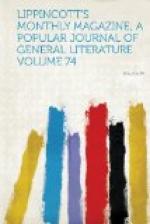Through the politeness of a gentleman who possesses half the street, I went over some of the houses, which are extremely spacious, and contain beautifully-proportioned rooms richly ornamented with carving and moulding. In what was formerly Mountjoy House I found a dining-room whose cornices and ceilings were of the most elegant design and execution. This house had seen many curious scenes. It was formerly the town-house of the earl of Blessington—whose second title was Viscount Mountjoy—to whom the whole street belonged. The founder of this family, Luke Gardiner, rose from a humble origin by energy and intrigue, and his son married the heiress of the Mountjoys. It was occupied up to 1830 by the last earl of Blessington, husband of the celebrated literary star. Soon after their marriage Lady Blessington accompanied her husband to Ireland, and he invited some of his friends who were ignorant of the event to dine at his house in Henrietta street. These latter were somewhat startled when he entered the room with a beautiful woman leaning on his arm whom he introduced as his wife. Among the guests was a gentleman who had been in that room only four years before, when the walls were hung with black, and in the centre, on an elevated platform, was placed a coffin with a gorgeous velvet pall, with the remains in it of a woman once scarcely surpassed in loveliness by the lady then present in bridal costume. This was the first Lady Blessington.
The last of the Irish noblesse in this street was Lady Harriet, widow of the Right Hon. Denis Bowes-Daly, on whom Grattan passed such warm eulogies, and who was the original of Lever’s happiest creation, The Knight of Gwynne.
It has been a frequent subject of conjecture why the Phoenix Park was so called. The best explanation seems to be that on a site within its boundaries there formerly stood, close to a remarkable spring of water, an ancient manor-house. The manor was called Fionn-uisge, pronounced finniske, which signifies clear or fair water, and this term easily became corrupted into Phoenix. The land became Crown property in 1559, and was made into a park in 1662. It was immensely improved and put into its present shape by the earl of Chesterfield, author of the Letters—one of the best viceroys Ireland ever had—about 1743. The area is seventeen hundred and sixty acres. With the exception of Windsor and our own Fairmount, no public park in the world can compare with it. The ground undulates charmingly, the views are extensive and beautiful.
Grouped around the Phoenix Park are many beautiful seats: the finest is Woodlands. This belonged formerly to the Luttrells, a notorious family, the head of which was raised to the Irish peerage as earl of Carhampton. It was with a Lord Carhampton that his son declined to fight a duel, not at all because he was his father, but because he “did not consider him a gentleman.” Early in the century, Woodlands, then known as Luttrellstown,




